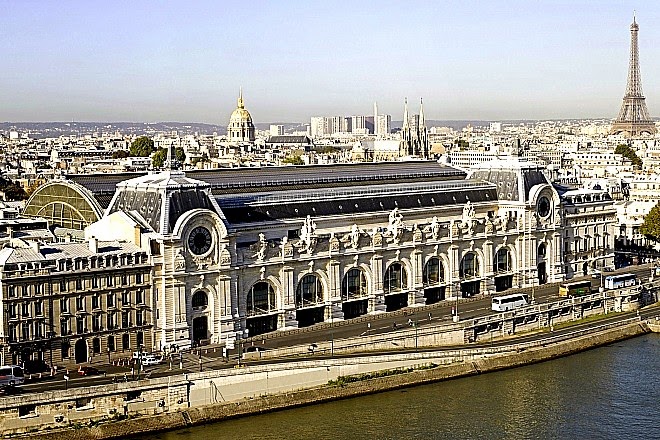In addition to the Louvre, the French capital has much more to offer.Art, history and architecture in the collections of five major museums in Paris .
1. Musée d'Orsay
A masterpiece of architecture, the museum is housed in what was until 1939 a train station iron and glass, the Gare d'Orsay . It contains the best collection of Impressionist and Post-Impressionist art between 1848 and 1914, exposed on three floors of galleries full of light. As if that were not enough, you have a beautiful view of the Seine River and the rive droite (right bank). Among the names of great artists, we must mention Monet, Renoir, Manet, Lautrec, Van Gogh and Degas. The museum serves as a sort of link between the fourth quarter of paint that is exposed in the Louvre and the Centre Pompidou works.
2. Centre Georges Pompidou
In ancient yet vibrant neighborhood of Le Marais, with more than 60,000 works of art of the twentieth century, this museum of glass, steel pipes and tubes and four colours (blue, green, yellow and red) in sight, receives thousands of visitors; It is undoubtedly one of the great attractions of Paris. Although the futuristic (the Pompidou is 1977) may seem somewhat exceeded, the building remains shocking. Among the schools of art that can be seen they include Cubism and Surrealism. And its major artists are Matisse, Derain, Chagall, Braque, Picasso, Giacometti, Pollock, Dali and Duchamp. Sooner or later, you have to sit in the square and admire Igor Stravinsky fountain that name and 16 mobile sculptures. The missed: a huge red lips mouth, which, like other works of art, moves in the water.
In ancient yet vibrant neighborhood of Le Marais, with more than 60,000 works of art of the twentieth century, this museum of glass, steel pipes and tubes and four colours (blue, green, yellow and red) in sight, receives thousands of visitors; It is undoubtedly one of the great attractions of Paris. Although the futuristic (the Pompidou is 1977) may seem somewhat exceeded, the building remains shocking. Among the schools of art that can be seen they include Cubism and Surrealism. And its major artists are Matisse, Derain, Chagall, Braque, Picasso, Giacometti, Pollock, Dali and Duchamp. Sooner or later, you have to sit in the square and admire Igor Stravinsky fountain that name and 16 mobile sculptures. The missed: a huge red lips mouth, which, like other works of art, moves in the water.
3. Picasso Museum
brings together the best work of Pablo Picasso in a palace. The collection was donated following a French law that allows pay less inheritance tax return for works of art. Are 200 paintings, sculptures 100 and about 3,000 drawings. There are works of all periods, which are added letters, photos and documents in his personal life, and you can tour the museum in chronological order.
4. National Museum of the Middle Ages Cluny
in the Latin Quarter, presents a wealth comprising 15 centuries of the history of Paris. And the collections are in two buildings connected with each other, one of them are the remains of a Roman bath of the second century BC, built by a group of shipowners. This is a museum that reflects the everyday life: furniture, jewellery, statues, manuscripts, paintings and the famous medieval tapestries, known as "The Lady with the Unicorn" as a whole. Elements that, in the past, decorated monuments such as the old windows of the Saint-Chapelle are also displayed. The decoration of the Cluny Museum, towers, gargoyles and friezes, sufficient in itself to stroll through this gothic monument.
in the Latin Quarter, presents a wealth comprising 15 centuries of the history of Paris. And the collections are in two buildings connected with each other, one of them are the remains of a Roman bath of the second century BC, built by a group of shipowners. This is a museum that reflects the everyday life: furniture, jewellery, statues, manuscripts, paintings and the famous medieval tapestries, known as "The Lady with the Unicorn" as a whole. Elements that, in the past, decorated monuments such as the old windows of the Saint-Chapelle are also displayed. The decoration of the Cluny Museum, towers, gargoyles and friezes, sufficient in itself to stroll through this gothic monument.
5. Musee Carnavalet
This is the museum of the history of Paris and complete, somehow, leaving without displaying the Cluny Museum: -the mansions on two hotels Le Peletier and Carnavalet-, some from the Middle Ages to 1789 and the other since the days of the French Revolution to the present.Most notably, the museum is the death mask of Napoleon I and jewellery art nouveau . Like something market in the Carnavalet you can see from the furniture of the writer Marcel Proust to a variety of objects related to the French Revolution. Being divided into -Photograph departments, archeology, sculpture, graphic arts, furniture , the tour needs a few hours.
This is the museum of the history of Paris and complete, somehow, leaving without displaying the Cluny Museum: -the mansions on two hotels Le Peletier and Carnavalet-, some from the Middle Ages to 1789 and the other since the days of the French Revolution to the present.Most notably, the museum is the death mask of Napoleon I and jewellery art nouveau . Like something market in the Carnavalet you can see from the furniture of the writer Marcel Proust to a variety of objects related to the French Revolution. Being divided into -Photograph departments, archeology, sculpture, graphic arts, furniture , the tour needs a few hours.





Niciun comentariu:
Trimiteți un comentariu